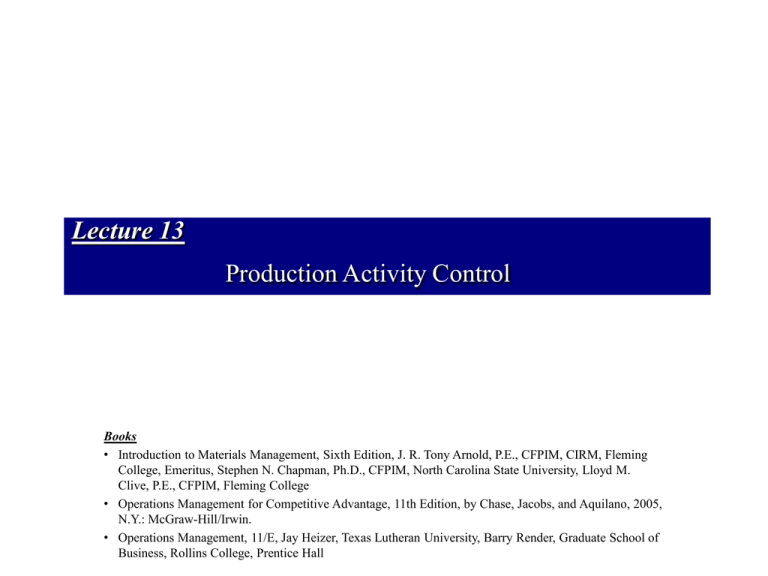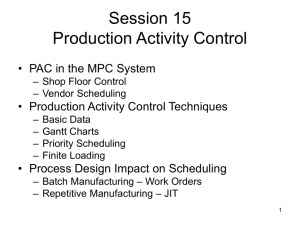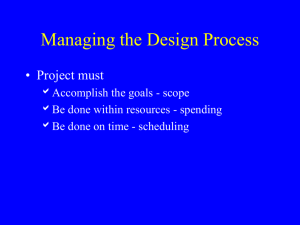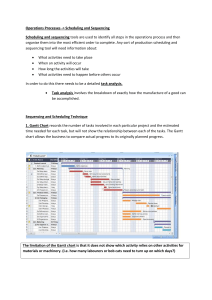MGT 3501 - Operations Management Fall 2005
advertisement

Lecture 13 Production Activity Control Books • Introduction to Materials Management, Sixth Edition, J. R. Tony Arnold, P.E., CFPIM, CIRM, Fleming College, Emeritus, Stephen N. Chapman, Ph.D., CFPIM, North Carolina State University, Lloyd M. Clive, P.E., CFPIM, Fleming College • Operations Management for Competitive Advantage, 11th Edition, by Chase, Jacobs, and Aquilano, 2005, N.Y.: McGraw-Hill/Irwin. • Operations Management, 11/E, Jay Heizer, Texas Lutheran University, Barry Render, Graduate School of Business, Rollins College, Prentice Hall Objectives • • • • • • Production activity control Gantt chart Critical ratio scheduling Finite loading Scheduling Assignment method Production Activity Control • PAC in the MPC System – Shop Floor Control – Vendor Scheduling • Production Activity Control Techniques – – – – Basic Data Gantt Charts Priority Scheduling Finite Loading • Process Design Impact on Scheduling – Batch Manufacturing – Work Orders – Repetitive Manufacturing – JIT 3 Production Activity Control in the MPC System 4 Basic Data Routing Data and Operation Setback Chart 6 Gantt Charts The incoming orders at Tom's Sailboard follow different routes through the shop but all orders must stop at each of the three work centers in the plant. The table below shows all tasks for four jobs that arrive over 5 days and need to be scheduled at the company. It is currently November 10 and Tom works a seven-day week. _____________________________________________________ Order (B)iff (G)riffin (H)erbie (K)errie Arrival Job/WC Processing time (days) date routing WC 1 WC 2 WC 3 Nov. 10 1-3-2 1 3 1 Nov. 10 2-3-1 2 2 2 Nov. 12 3-2-1 3 1 2 Nov. 14 2-1-3 1 3 1 Assume that the new material for all orders is in stock and that a first-come/first-served sequencing rule is used at all work centers. All three work centers are idle as work begins on orders B and G on November 10. Tom’s Sailboard a. Construct a Gantt chart depicting the processing and idle times for the three work centers for these four jobs. Order (B)iff (G)riffin (H)erbie (K)errie Arrival date Nov. 10 Nov. 10 Nov. 12 Nov. 14 Job/WC routing 1-3-2 2-3-1 3-2-1 2-1-3 Processing time (days) WC 1 WC 2 WC 3 1 3 1 2 2 2 3 1 2 1 3 1 Tom’s Sailboard b. How many days does each job wait in queue for processing at work center 2? The determination of how long jobs wait at work center 2 is as follows: B and G are processed immediately at work center 2, order K must wait 1 day (11/14) and order H waits 4 days (11/12, 11/13 at WC3) and (11/16 and 11/17 at WC2). Priority Sequencing Rules • • • • First Come, First Served Shortest Operation Next Earliest Due Date Order Slack: (Time Remaining until Due Date – Sum of Remaining Setup and Run Time) • Slack per Operation • Critical Ratio: (Due Date-Now)/(Lead Time Remaining) ________________________________________ Lead Time Remaining includes setup, run, move and queue time for all remaining operations. Knox Machine 2. The jobs below are waiting to be processed at the P&W Grinder at the Knox Machine Company. (There are no other jobs and the machine is empty.) __________________________ Job A B C D Machine processing time (in days)*__ 4 1 5 2 6-23 6-24 7-01 6-19 Date job arrived at this machine 8-15 9-10 8-01 8-17 Job due date__ *Note: This is the final operation for each of these jobs. ___________________________________________________________ Knox Machine: Solution a. The production manager has heard about three dispatching rules: the Shortest Operation Next Rule, the First-Come/First-Served Rule, and the Earliest Due Date Rule. In what sequence would these jobs be processed at the P&W grinder if each rule was applied? 1. 2. 3. Job A B C D The shortest operation next rule: B-D-A-C The first-come, first-served rule: D-A-B-C The earliest due date rule: C-A-D-B Machine processing time (in days)*__ 4 1 5 2 Date job arrived at this machine 6-23 6-24 7-01 6-19 *Note: This is the final operation for each of these jobs. Job due date__ 8-15 9-10 8-01 8-17 Knox Machine: Solution b. If it's now the morning of July 10 and the Shortest Operation Next Rule is used, when would each of the four jobs start and be completed on the P&W grinder? (Express your schedule in terms of the calendar dates involved, assuming that there are 7 working days each week.) P & W Grinder Job B Date 7/10 D 7/11 A 7/12 7/13 7/14 7/15 C 7/16 7/17 7/18 7/19 7/20 7/21 Critical Ratio Scheduling Eight weeks remain for constructing the a 50foot yacht. Assume that each week consists of 5 work days, for a total lead time of 40 days. The work required to complete the yacht comprises 10 operations, 4 days for each. Yacht Project Example a. On Tuesday morning of week 3, 3 of the 10 operations had been completed and the yacht was waiting for the fourth operation. What's the critical ratio priority? Time Remaining 40 11 Critical Ratio 1.04 Work Remaining 28 Yacht Project Example b. What's the critical ratio priority if only 2 of the 10 operations are completed by Tuesday morning of week 3? Time Remaining 40 11 Critical Ratio .91 Work Remaining 32 Finite Loading The Bundy Company The Bundy Company produces for three products (A, K, and P). Each order goes through the same three machine centers, but not necessarily in the same sequence. Each order must be finished at a machine center before another can be started. Orders cannot be split. The shop works a single eight-hour shift five days per week. Assume that the time to move between machines is negligible. each machine center is operated eight hours per day. All three machines are currently available for scheduling, and no further orders will arrive. The Bundy Company Machine center Order routing1 A 3-1-2 K 2-3-1 P 3-2-1 Processing time at machine center ___(in days)____ Order 2 3 due date 1 3 2 14 3 1 3 12 2 3 4 10 Note: Order due dates are fixed based on the shop calendar. It is now 8:00 A.M. Monday (day 1), Monday of next week is day 6, etc. The Bundy Company Using the horizontal loading procedure with earliestdue-date priority sequencing rule, prepare a Gantt chart showing the production schedule for the three orders above. Machine Center 1 P-3 Machine K–1 Center 2 Machine Center 3 P-2 P-1 1 K-3 2 A-3 K-2 3 4 5 6 A-2 A-1 7 8 9 10 11 12 13 14 15 16 17 18 The Bundy Company Using the vertical loading procedure and the shortestoperation-next priority sequencing rule, prepare a Gantt chart showing the production schedule for the three orders above. Machine Center 1 K-3 A-2 Machine K-1 Center 2 Machine Center 3 A-3 A–1 1 P-3 2 P-2 K-2 3 4 P-1 5 6 7 8 9 10 11 12 13 14 15 16 Process Design Impact Scheduling • Batch Manufacturing: Work Orders • Repetitive Manufacturing: JIT/Kanban Scheduling What is Scheduling? • Last stage of planning before production occurs • Specifies when labor, equipment, and facilities are needed to produce a product or provide a service Scheduled Operations • Batch Production • Process Industry – Linear programming – Aggregate planning – EOQ with non– Master scheduling instantaneous – Material requirements replenishment planning (MRP) • Mass Production – Assembly line balancing – Capacity requirements • Project planning (CRP) – Project -scheduling techniques (PERT, CPM) Objectives in Scheduling • • • • • Meet customer due dates Minimize job lateness Minimize response time Minimize completion time Minimize time in the system • Minimize overtime • Maximize machine or labor utilization • Minimize idle time • Minimize work-in-process inventory Shop Floor Control (SFC) • Schedule and monitor day-to-day job shop production • Also called production control and production activity control (PAC) • Performed by production control department – Loading - check availability of material, machines, and labor – Sequencing - release work orders to shop and issue dispatch lists for individual machines – Monitoring - maintain progress reports on each job until it is complete Loading • Process of assigning work to limited resources • Perform work with most efficient resources • Use assignment method of linear programming to determine allocation Assignment Method 1. Perform row reductions – subtract minimum value in each row from all other row values 2. Perform column reductions – subtract minimum value in each column from all other column values 3. Cross out all zeros in matrix – use minimum number of horizontal and vertical lines 4. If number of lines equals number of rows in matrix, then optimum solution has been found. Make assignments where zeros appear ‾ ‾ ‾ ‾ Else modify matrix: subtract minimum uncrossed value from all uncrossed values add it to all cells where two lines intersect other values in matrix remain unchanged 5. Repeat steps 3 and 4 until optimum solution is reached Assignment Method Initial Matrix Bryan Kari Noah Chris 1 10 6 7 9 Row reduction 5 4 2 5 0 0 1 1 1 2 0 0 5 4 1 6 PROJECT 3 6 4 5 4 2 5 2 6 5 4 10 6 6 10 Column reduction Cover all zeros 3 2 0 3 3 2 0 3 0 0 1 1 1 2 0 0 4 3 0 5 Number lines number of rows so modify matrix 0 0 1 1 1 2 0 0 4 3 0 5 Assignment Method Modify matrix 1 0 1 0 0 2 0 3 2 1 1 0 Cover all zeros 1 0 1 0 0 2 0 3 2 1 1 0 2 1 0 3 2 1 0 3 Number of lines = number of rows so at optimal solution Bryan Kari Noah Chris 1 1 0 0 1 PROJECT 2 3 0 1 0 2 3 2 1 0 4 2 1 0 3 Bryan Kari Noah Chris 1 10 6 7 9 Project Cost = (5 + 6 + 4 + 6) X $100 = $2,100 PROJECT 2 3 4 5 6 10 2 4 6 6 5 6 5 4 10 Assignment Method - Setup Solution goes here Only 1 leader can be assigned to each project Click “Solve” for solution Sum of all rows and columns = 1 Assignment Method - Solution Assignments indicated by 1 Cost of solution End of Lecture 13







